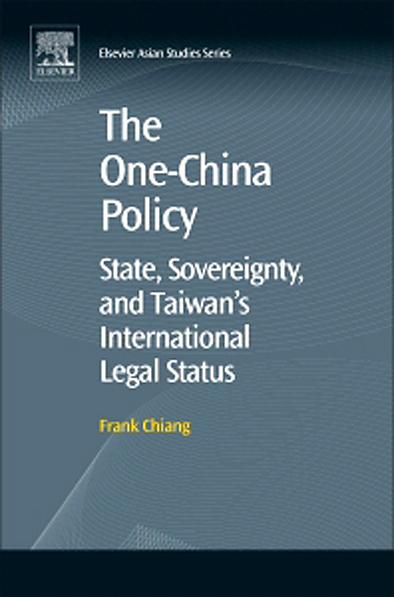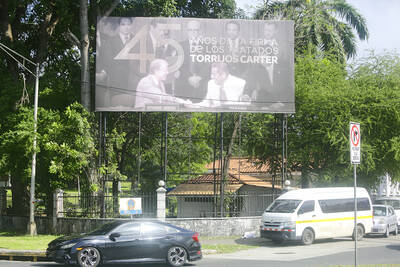This work is by far the most complete and extensive legal treatise of the “one China” policy ever. Frank Chiang (江永芳) of New York’s Fordham Law School discusses in great detail this much-discussed but little understood topic. The book received a glowing foreword by Jerome Cohen of the New York University of Law, and an incisive afterword by former US diplomat John J. Tkacik Jr.
In the first part, Chiang first defines and analyzes the history and legal definitions of the concepts of the state, sovereignty and the territorial state, establishing a foundation for his treatment of Taiwan’s status in the later chapters.
In the second part, he describes the history of the Chinese state, and the successive governments in modern China. He then analyzes the positions taken by the Lee Teng-hui (李登輝), Chen Shui-bian (陳水扁), Ma Ying-jeou (馬英九) and Tsai Ing-wen (蔡英文) administrations on Taiwan’s sovereignty.

In the book’s third section, Chiang analyzes sovereignty over Taiwan before and under the US’ “one China” policy and also goes into the UN’s position on sovereignty over Taiwan, as well as the legal and political status of Taiwan under international law. In part four, Chiang examines US policy towards Taiwan, and presents a number of recommendations.
A fundamental point in Chiang’s analysis is that a state, its territory and sovereignty are closely interlinked. In other words, a state is predicated on a territory: If a state has no title to a territory, it has no sovereignty over the territory and the people residing in the territory. A state acquires a piece of territory of another state only by a formal transfer of title — a treaty.
Chiang also analyzes a number of documents and declarations, such as the 1943 Cairo Declaration, the 1945 Potsdam Declaration and even the 1971 UN Resolution 2758 — which are often quoted as having a bearing on Taiwan’s status — and concludes that none of them are relevant to Taiwan’s status: the first two were simply declarations of intent, and were not carried out, while the 1971 UN Resolution was about the representation of “China” in the UN, and didn’t even mention Taiwan.
Sovereignty
Chiang thus clearly distinguishes between the respective governments, the territories they control and whether they have obtained sovereignty through a formal treaty. With his argument he debunks both the Chinese Nationalist Party (KMT) governments after 1949 (which still claimed sovereignty over China) and the People’s Republic of China (PRC) government in Beijing, which continues to claim sovereignty over Taiwan.
The book does much to clarify the muddy situation from 1949 through the early 1990s, during which both the PRC and Republic of China (ROC) governments claimed sovereignty over China and Taiwan. Under Chiang’s analysis neither of the cross-claims had any legal basis.
He also argues that during that time, the KMT had no sovereignty over Taiwan — although it controlled the territory — due to the fact that it never formally obtained sovereignty through a territorial treaty. US State Department documents show that for many decades this was also the position of the US government.
Taiwan a state or not?
Matters get more complex after Taiwan’s transition to democracy in the early 1990s. Starting with Lee, the successive governments argued that with democracy achieved, sovereignty belonged to the people, and that Taiwan/ROC was a state. Chiang disagrees, saying that a state can only become a state if there is a formal declaration to that effect.
He thus subscribes to the “declaratory theory,” unlike his well-known Taiwanese colleague Chen Lung-chu (陳隆志), chairman of Taiwan New Century Foundation and professor emeritus at the New York Law School, who has argued in favor of the “evolutionary theory,” under which an entity gradually evolves into a state, as it fulfills the requirements of the 1933 Montevideo Convention, which is generally accepted as the definition of a state: defined territory, permanent population, a functioning government and the capacity to enter into relations with other states.
The work is excellent in that it is highly readable, avoiding complex legal phraseology and discussing the key issues in a clear fashion.
On the minus side, somehow the author gets quite a number of dates and specific facts wrong: Chiang Kai-shek (蔣介石) died in 1975, not in 1978 (page 137); the woman selling contraband cigarettes that led to the 228 Incident was beaten by Monopoly Bureau officials, but did not die: a bystander was shot and killed (page 132). Carnegie Mellon professor Chen Wen-chen (陳文成) died in 1981 after being questioned by officers of the Taiwan Garrison Command (one of the secret police organizations at the time), not by Military Security Guards (page 140). The Olympic Games agreement to use “Chinese Taipei” stems from the so-called Nagoya Resolution of 1979, not from 1988 (page 174).
Overall conclusion: highly recommended for those who wish to understand the ins and outs of the “one China policy.” The work dispenses with a number of major misperceptions which have muddied the understanding of the concept. It does present a clear vision for Taiwan’s future as a free and democratic country, but makes the road ahead more cumbersome by subscribing to the “declaratory theory” instead of the “evolutionary theory.”
Under the former, Taiwan would need to declare itself an independent state. Under the latter, it is already a sovereign state, and diplomatic ties will materialize as it asserts itself on the international stage as a free and democratic nation. Chiang has provided an excellent basis for the undoubtedly extensive further analyses and intensive discussions to come.

April 14 to April 20 In March 1947, Sising Katadrepan urged the government to drop the “high mountain people” (高山族) designation for Indigenous Taiwanese and refer to them as “Taiwan people” (台灣族). He considered the term derogatory, arguing that it made them sound like animals. The Taiwan Provincial Government agreed to stop using the term, stating that Indigenous Taiwanese suffered all sorts of discrimination and oppression under the Japanese and were forced to live in the mountains as outsiders to society. Now, under the new regime, they would be seen as equals, thus they should be henceforth

Last week, the the National Immigration Agency (NIA) told the legislature that more than 10,000 naturalized Taiwanese citizens from the People’s Republic of China (PRC) risked having their citizenship revoked if they failed to provide proof that they had renounced their Chinese household registration within the next three months. Renunciation is required under the Act Governing Relations Between the People of the Taiwan Area and the Mainland Area (臺灣地區與大陸地區人民關係條例), as amended in 2004, though it was only a legal requirement after 2000. Prior to that, it had been only an administrative requirement since the Nationality Act (國籍法) was established in

Three big changes have transformed the landscape of Taiwan’s local patronage factions: Increasing Democratic Progressive Party (DPP) involvement, rising new factions and the Chinese Nationalist Party’s (KMT) significantly weakened control. GREEN FACTIONS It is said that “south of the Zhuoshui River (濁水溪), there is no blue-green divide,” meaning that from Yunlin County south there is no difference between KMT and DPP politicians. This is not always true, but there is more than a grain of truth to it. Traditionally, DPP factions are viewed as national entities, with their primary function to secure plum positions in the party and government. This is not unusual

US President Donald Trump’s bid to take back control of the Panama Canal has put his counterpart Jose Raul Mulino in a difficult position and revived fears in the Central American country that US military bases will return. After Trump vowed to reclaim the interoceanic waterway from Chinese influence, US Defense Secretary Pete Hegseth signed an agreement with the Mulino administration last week for the US to deploy troops in areas adjacent to the canal. For more than two decades, after handing over control of the strategically vital waterway to Panama in 1999 and dismantling the bases that protected it, Washington has